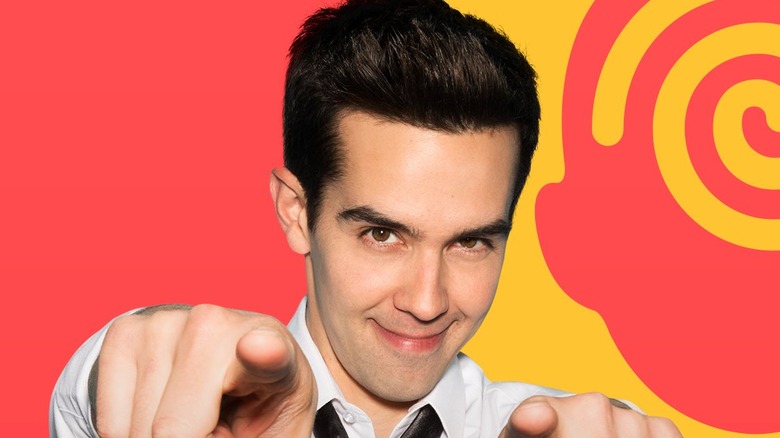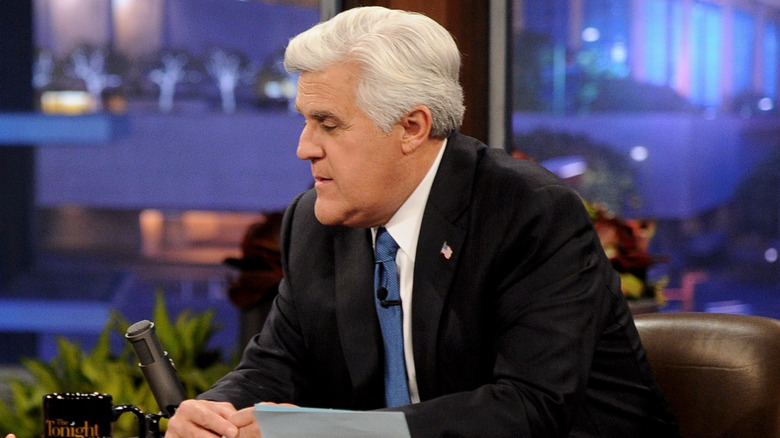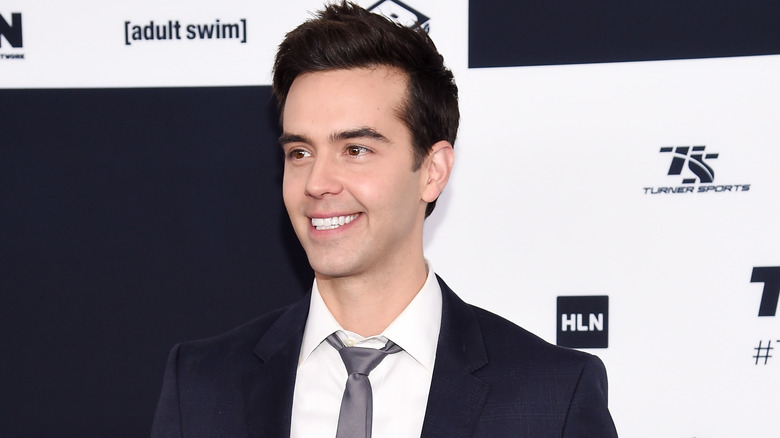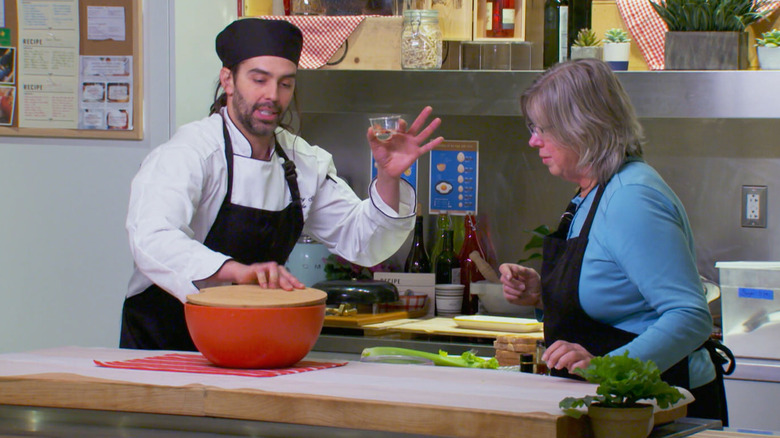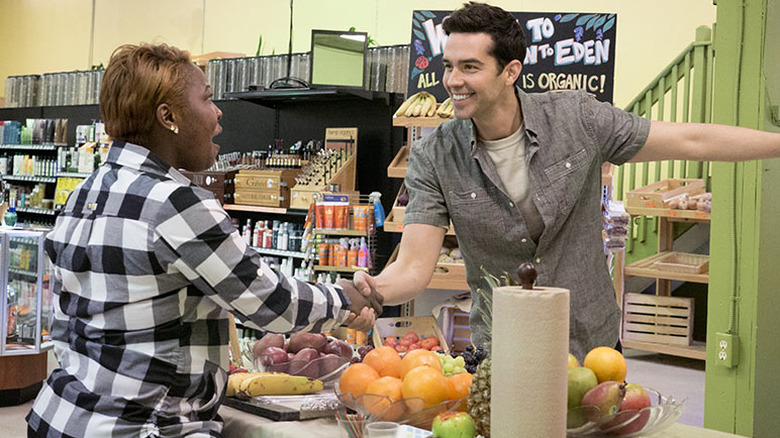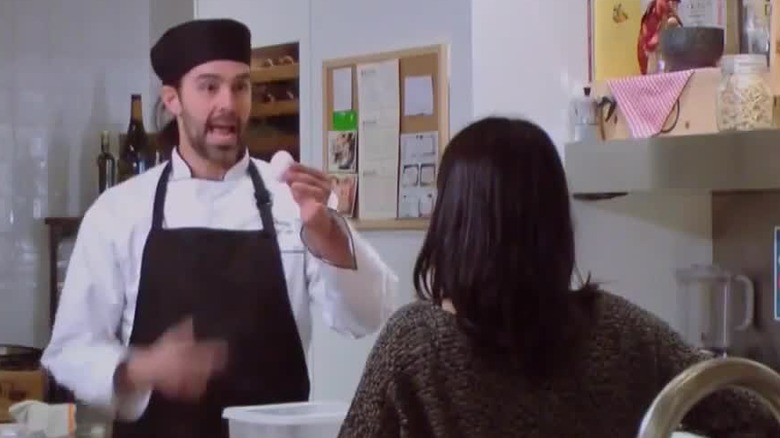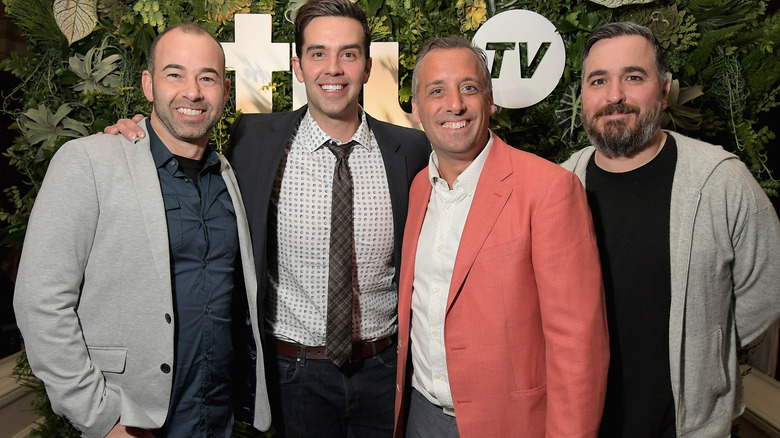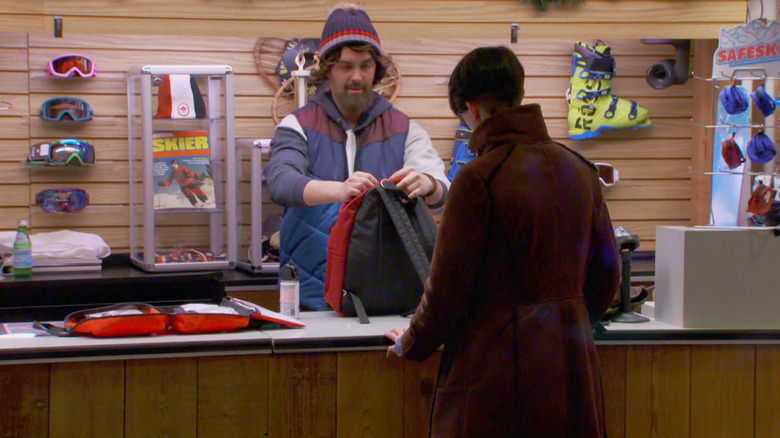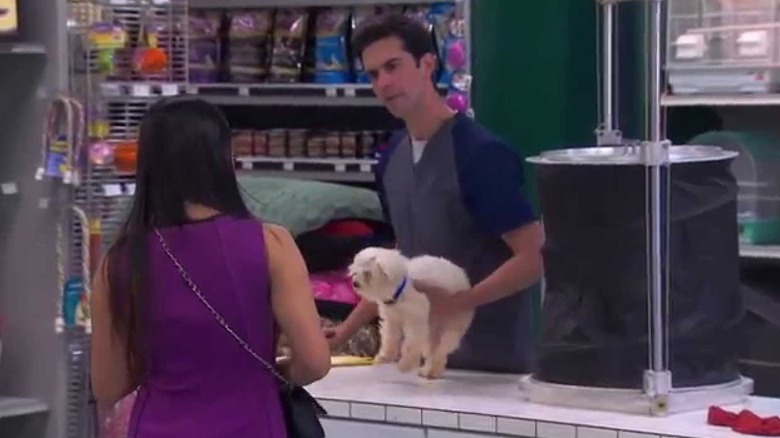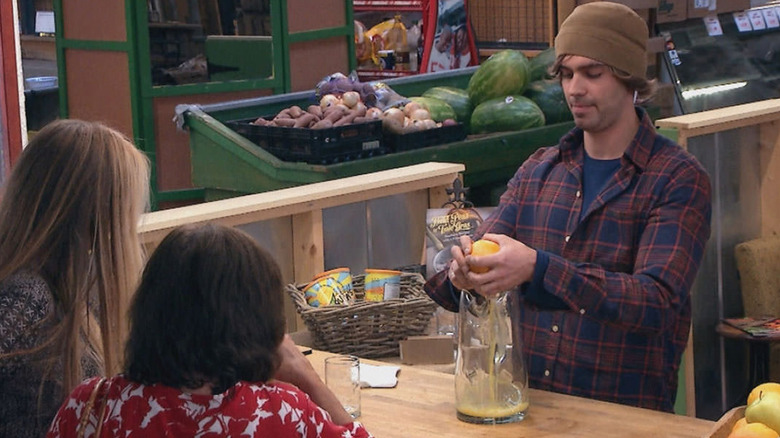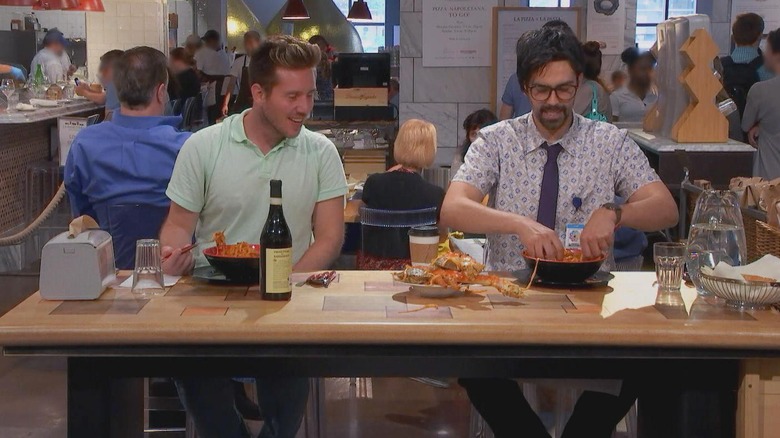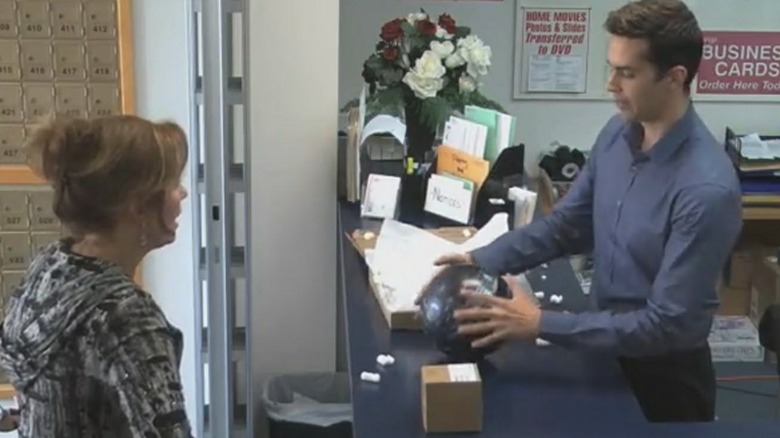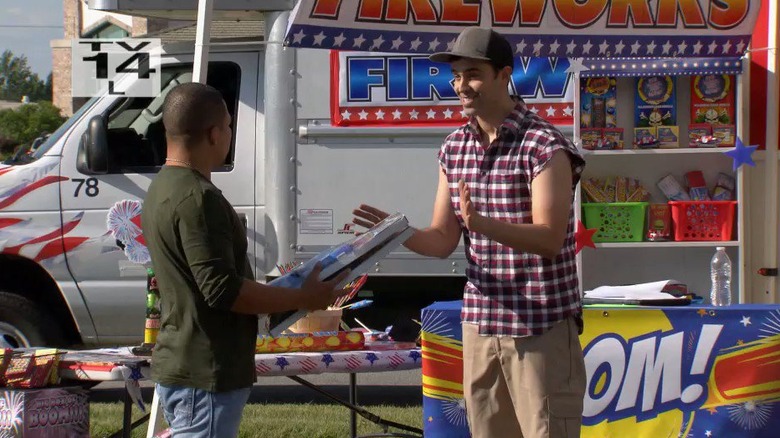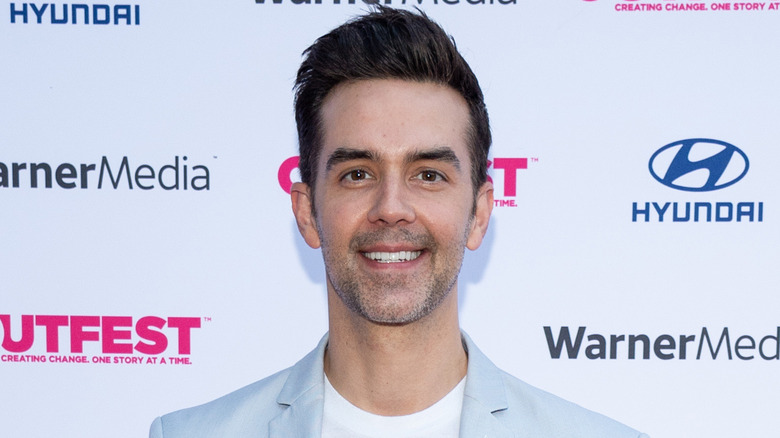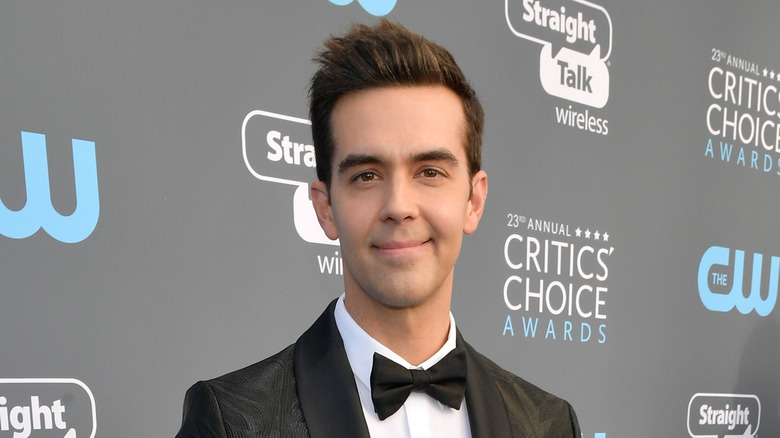The Carbonaro Effect: 14 Facts Only True Pranksters Will Know About The Show
From the spells of Harry Potter to the special effects makeovers of "Face Off," modern magic comes in many forms. When it comes to actual magicians performing tricks and illusions, the spectrum is just as great. We have large-scale performers like Criss Angel and David Copperfield performing incredible feats of seeming impossibility to the lower-key sleight of hand that takes just as much skill and coordination. Airing for the first time on April 1, 2014, "The Carbonaro Effect" focuses on this latter style of magic, with its close-up tricks taking place in everyday scenarios like the supermarket or mall. Inspired by the "Candid Camera" hidden camera show, "The Carbonaro Effect" takes the concept even further with elaborate pranks that even fool viewers at home.
In the first episode, host Michael Carbonaro pretends to be a phone tech who pulls an actual bug out of a customer's broken phone. He also fools bar patrons with a never-ending bottle of beer as well as convincing a set of office co-workers that he's able to freeze and bring animals back to life. But it's not just the tricks on "The Carbonaro Effect" that are magical — watching the amazement spread across participants' faces as the trick unfolds and the eventual joy when the illusion has been revealed is a special magic all its own. And now, with dozens of episodes and hundreds of tricks under its belt, we have to ask: How does "The Carbonaro Effect" do what it does? Let's stick our hand into this top hat and see what emerges.
The Carbonaro Effect started as a skit on The Tonight Show
In 2013 on "The Tonight Show," a young magician named Michael Carbonaro posed as a convenience store clerk in order to trick unwitting customers into believing the unbelievable. Starting with a special Easter skit, the first "Magic Clerk" sketch quickly went viral and eventually led to Carbonaro's regular appearances on Jay Leno's late-night talk show. Talking to HuffPost about the "Magic Clerk" skits, Carbonaro's magician peers Penn and Teller said, "What makes it great is not just the ingenuity of the stunts — which are amazing — but Carbonaro's sweet, sly style." It isn't just Carbonaro's charm, charisma, and photogenic presence that helps him pull off the skits, it's also the highly detailed backstage and under-the-table preparation that makes these illusions visually stunning.
In the same interview with HuffPost, Carbonaro said, "In doing the 'Magic Clerk' segments, I'm always reminded of that line from 'The Usual Suspects' — 'The best trick the Devil ever pulled was convincing the world he didn't exist.'" Thankfully, Carbonaro's best tricks don't involve anything truly devilish, even though there is the occasional bit of mayhem. And after just one year on Leno's show, a newly renamed "The Carbonaro Effect" was picked up by TruTV and an entire season ordered even before the first episode aired.
The Carbonaro Effect was sued by the co-creator of The Tonight Show sketch
Even though the "Magic Clerk" skits exceeded all expectations by getting picked up by TruTV as "The Carbonaro Effect" after just a year on "The Tonight Show," unfortunately there was trouble in magician's paradise. Michael Carbonaro was sued in 2015 by "Tonight Show" producer Beth Einhorn, who alleged they had entered into a 50/50 verbal contract in 2012 to create a spinoff show of "Magic Clerk" tentatively titled "TrickShow." Einhorn claimed that "The Carbonaro Effect" is exactly the premise of the show she and Carbonaro had discussed, and she sued him for damages, fraud, fiduciary duty breach, unfair competition, and conversion. The results of the California lawsuit are still noted as pending, but Einhorn is now listed as a producer of "The Carbonaro Effect" on her website, suggesting the incident was settled out of court. However, no further details of any settlement have been released.
The Carbonaro Effect is, in fact, staged
Sometimes the most interesting aspect of a trick is how it's accomplished, even if that might take the magic out of the moment. Because the illusions on "The Carbonaro Effect" are often so confounding, many viewers can't help but wonder if these acts are coordinated. The truth is the illusions and pranks are actually staged, but only to an extent. "The Carbonaro Effect" has a team of 30 people and for each trick uses six cameras picking up a variety of angles that are later edited frame by frame to show the trick taking place in almost real time. The editing process is extensive and requires incredible attention to detail in order to show the trick as seamlessly as possible.
"The Carbonaro Effect" uses gentle suggestions like footprint markings on the floor that subtly encourages a participant to stand in an optimal spot for both the trick and the cameras. If bystanders begin to accumulate, Carbonaro's team will come out of the woodwork posed as people who work in the same space and effectively block the gawkers' view. If by chance someone recognizes the show's host, he simply moves on to the next customer.
Host Carbonaro also uses an improvisation technique that involves saying "Yes" to anything a participant might suggest to get them further invested and engaged in the event. He uses these techniques to exploit what he calls the "wedge of belief," which is that small space where an individual has left themselves room to imagine the impossible is true.
The Carbonaro Effect uses sleight of hand to plant microphones on participants
In order to fully capture the trick from all perspectives, including the pranked, Michael Carbonaro uses his training to plant a microphone on the unwitting participants using sleight of hand. Carbonaro calls this a "reverse pick-pocket" and it's extremely effective in capturing the shock and awe that inevitably arises as the trick unfolds. In other cases where appropriate, Carbonaro's team will plant a mic in an object such as a heart rate monitor or clothing for the participant to try on. Many of the participants are shocked to realize their reactions have been getting recorded all along, and not just by the cameras. Because of all this, even though aspects of "The Carbonaro Effect" are staged, the human reactions are not. That aspect is enchanting all on its own.
Carbonaro is also sensitive to the nature of his trickery, and makes sure that the joke doesn't enter into scary or bullying territory. If a participant starts to get uncomfortable or feels they're being made fun of, Carbonaro will stop the prank, reset, and move on to the next person.
Carbonaro also understands that sometimes it's more than just vanity that makes people hesitant to agree to appear on camera. Occasionally people are out and about to avoid their family, who might not know where they really are. Carbonaro totally respects that, and their privacy. In these cases, he simply moves on to the next mark. Someone go tell Voldemort and Dolores Umbridge that there's no room for meanness in magic.
There are three elements to every trick
Three is the magic number for the main elements in a "Carbonaro Effect" trick in order to achieve its maximum potential, which Carbonaro calls "The Perfect Triad."
First is the trick, which needs to strike a fine balance between being simple as well as appearing incredibly complicated — the quantum physics of magic. Carbonaro returns to magic basics, "Magic 101," that relies on sleight of hand since this is a most effective aspect.
Second, Carbonaro needs a solid story to complement the Magic 101 going on behind the scenes. Since "The Carbonaro Effect" often takes place in retail scenarios, Carbonaro needs to sell himself not as a celebrity magician, but as an everyday Joe who's giving out free samples or doing a demonstration of a new piece of tech. Without this narrative background, it would be impossible to get people to believe they're witnessing a miracle. And especially since, well, they actually aren't.
The third, and arguably most important, aspect of a trick is the participant's reaction to it. "What I think is at the heart of [the show] is the joy of watching people react to bizarre situations," Michael Carbonaro has said. "I could be great, but the reaction is the super star.... If the trick is really great, the silly story that I tell along with it is really great, and the person that I am lucky enough to have wander into this scenario is also an awesome person; if those three things are lined up, it's golden."
The Carbonaro Effect teamed up with Impractical Jokers
"Impractical Jokers" is another hidden camera prank show featured on TruTV that involves a group of four friends daring each other into increasingly ridiculous and personally embarrassing situations. The person who refuses, loses, and is faced with an even more absurd dare to close out each episode. While "Impractical Jokers" isn't nearly as finessed as "The Carbonaro Effect" in either theme or execution, pairing the two popular shows still makes perfect sense.
In a hilarious crossover event, "Impractical Jokers Murr," Q, Joe, and Sal joined Michael Carbonaro in a coffee shop to prank some unsuspecting New Yorkers. But as to be expected with "The Carbonaro Effect," the joke ended up on the Jokers who were supposed to be helping prank customers. Carbonaro's original setup involves magically filling bags with coffee beans without actually opening the bag, let alone sealing it. But by the time the Jokers get involved, Carbonaro switches the prank and the Jokers end up stunned themselves as Carbonaro's smooth magic takes place right in front of them without them even realizing. "Impractical Jokers" fans are right in assuming there was a whole lot of yelling involved, both in front of and behind the camera.
Michael Carbonaro is a trained magician
Growing up, Carbonaro was inspired by the prank show "Candid Camera" and first got into magic by imitating his hero David Copperfield. In an interview with Newsday, Carbonaro recalled, "I learned how to be a performer by emulating him as a kid — his formula of just talking to people onstage, being free to improvise, being charming and witty with a crowd, together with great, beautiful magic." After summers attending Tannen's Magic Camp, he went on to teach himself a variety of magic tricks and sleight of hand through relentless practice in front of a mirror until the illusions were seamless. Once he was able to fool his family, they joined forces to help him to branch out and get paid for his performances starting when he was just 13. Encouraged by his electrician dad who would help build sets for his tricks, and his nurse mom who took on the role of both booker and manager for her son, Carbonaro's flair for both magic and performing flourished. He made enough money performing magic tricks during high school that he saved enough money to put himself through prestigious (and expensive) NYU, where he studied acting professionally.
In an interview with Interrobang about his magical training, Carbonaro said, "I had this love/hate relationship with magic; magic can sometimes be a bad word.... [A] lot of people — they think of their dumb uncle or some stupid clown that they saw. They don't really know that magic can be super skilled and super wonderful." And certainly the way "The Carbonaro Effect" approaches magic is absolutely both of those things. Super skilled. Super wonderful.
The tricks are all original and designed by Carbonaro and his team of magicians
Inspired by the practical special effects of horror movies as well as Steven Spielberg films like "E.T.," "Jaws," and "Jurassic Park," Carbonaro insists that the tricks must be doable in real time. They don't even use camera tricks.
Carbonaro and his writing room use an unconventional reverse method in conceiving their tricks. Instead of thinking about what they can do, they think about something impossible to do, and then work out the details of how to accomplish it successfully on camera. He likens some of their concepts to episodes of "The Twilight Zone" — for example, the Scarecrow Transformation episode — where they think of something that might be considered terrifying or creepy and turn it into a magic trick that leaves people stunned more than frightened.
He has 30 people on his team who help with the various aspects of each trick, and a portion of them are involved with the six cameras involved. This means that there's always one camera that catches the illusion in the act, which of course gets edited out before the episode airs.
"The Carbonaro Effect" team even includes people Carbonaro went to magic camp with, who continue helping him design and execute these "magical moments" as Carbonaro likes to call his tricks.
The Carbonaro Effect team has a restricted timeline for filming
As much as Michael Carbonaro would love to practice and hone his tricks more with participants, "The Carbonaro Effect" has a limited timeline to film ten episodes in a mere 13 weeks. This amounts to upwards of 140 tricks that he and his team must not only design, but rehearse without the beautiful human reactions that really bring the magic home. For example, the stunning Everlasting Juicer trick was shot a grand total of two times. The level of creativity displayed here is as stunning as the magic and Carbonaro's performances themselves.
The show might start disguising Carbonaro
"As I get better at pulling this stuff off, I have less people to pull it off on," Carbonaro told Reality Blurred. "It becomes harder and easier at the same time." He's now starting to face the problem of people recognizing him too often, which will affect how audiences perceive the magic in the long term. Since he's looking for authentic reactions to an unreal situation, it doesn't work if people are warned ahead of time that a famous magician is in the building. And because the show has such a limited timeline for filming, it's not like they can just pick up and go somewhere new if a potential participant announces to a grocery store or mall that Michael Carbonaro is filming his magic tricks there. Reality Blurred writer Andy Dehnart suggested a "Drag Race" crossover episode where Carbonaro does his show in full drag, to which Carbonaro fanboyed, "Let me put it this way: I would die at the opportunity."
While it makes perfect sense that Carbonaro's fame would begin to precede him, there are still cases of people who watch "The Carbonaro Effect" who get so caught up in the magic that they forget they know who he is. That's a different kind of magic entirely, although those forgetful folks might want to schedule a quick visit to the neurologist just to be on the safe side.
One Carbonaro Effect viewer found a continuity error which caused a small controversy
Because every party has a pooper, especially when it comes to something intricate like magic, people are constantly looking to prove "The Carbonaro Effect" is fake, even though the showrunners and host are perfectly open about all the different staging aspects of each trick. A Reddit user posted a video on YouTube accusing the show of using planted actors rather than the real folks they claim to use. The skit was the flat-packed bowling ball bit, and Carbonaro countered the accusation by releasing the unedited footage of the trick. Because the participant wasn't actually watching as the bowling ball first emerged, Carbonaro quickly resets the gag without her noticing and executes it to her shocked reaction. The Redditor ended up issuing an open apology to Carbonaro for his video and comments.
The Carbonaro Effect is filmed in Georgia and Chicago, but Carbonaro would love to work in New York
"The Carbonaro Effect" host might be born and bred in Long Island, but his show has been filmed in Georgia and Chicago in order to capitalize off a potentially less cynical population. Locations are also easier to disguise outside of a well-photographed New York landscape that might alert people to Carbonaro's presence and upstage the tricks with participants who know too much about him already.
That said, Carbonaro already knows exactly what trick he would do if given the chance to bring "The Carbonaro Effect" to his home state, and of course it involves the subway. He hasn't revealed a lot of detail, only that it would rely on a subway platform, a moving train, and Carbonaro "being a nutjob." The focus would be on the subway riders' faces as they watched the scenario unfold. Carbonaro also thinks filming around New York would be great because of all the swearing that would inevitably need bleeping out as his tricks unfold — presenting Carbonaro and his team with new creative challenges they'd embrace with their signature passion.
The show's title comes from Carbonaro's unique skillset
It can be difficult to pin down exactly what genre "The Carbonaro Effect" belongs to. Sure, the sleight-of-hand magic is the central draw, but there are many elements happening at once. That unique combination is actually what inspired the original name of the series.
Speaking with Heavy about his show, Carbonaro explained that coming up with a name was difficult. "Was it a comedy show, a prank show, a magic show? I could never really answer that question. I thought, 'I've done TV, stand-up comedy, and magic,' and this show puts them all together at [once] to create its own effect."
It may not be the most revolutionary name in the world, but it certainly matches Carbonaro's one-of-a-kind talent set. It's also a very easy name for him to continue to brand, as he demonstrated with his behind-the-scenes episodes of "The Carbonaro Effect: Inside Carbonaro" and "The Carbonaro Effect: Double Takes."
Why did the series end after five seasons?
When a show has as unique of a premise as "The Carbonaro Effect," you'd think it could go on forever. When promoting his on-stage magic show "Carbonaro: Lies on Stage," the performer said that there was no more magic up his sleeve for "The Carbonaro Effect."
Speaking with Atlantic City Weekly, Carbonaro explained that the show's success is what actually gave it a limited shelf life. After the fifth season, he explained that he and the team "talked about revamping it, changing it, maybe coming back with it ... I have all these fans say, 'Oh my gosh, I love your show so much and I wish I could be on it, but I can't because I know who you are.'" It defeats the purpose of a hidden-camera-style series if people start looking for hidden cameras as soon as they recognize the host on the street.
Fans of Carbonaro's talents need not worry, as he'll be back on your screen before too long. In the same interview, Carbonaro says he has a development deal in place on a new show that will continue to showcase his talents.
